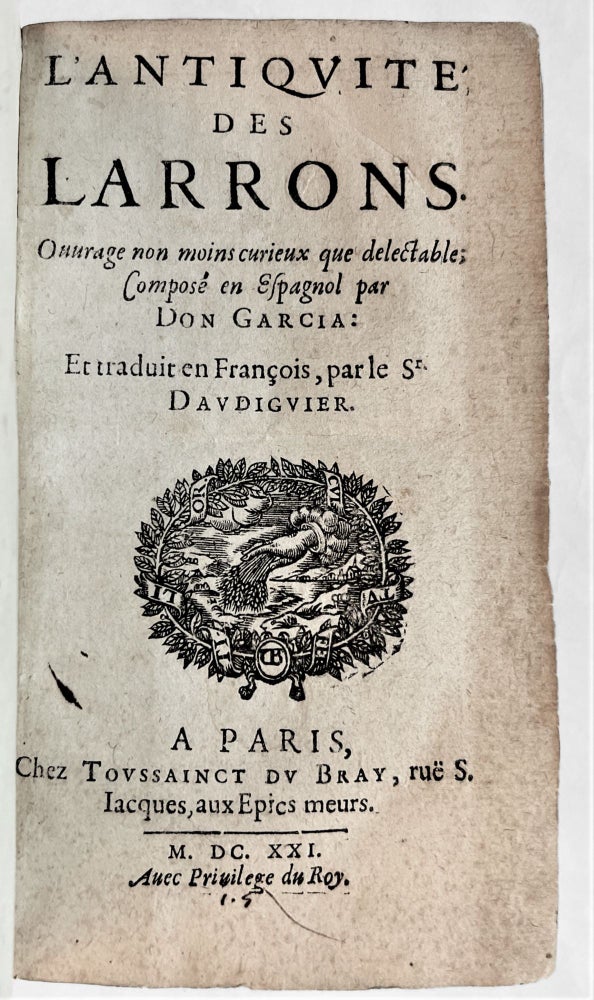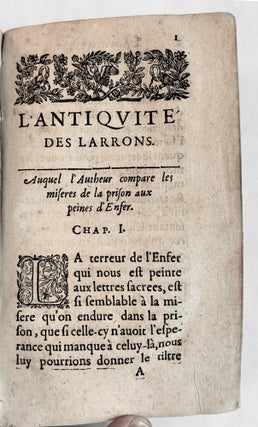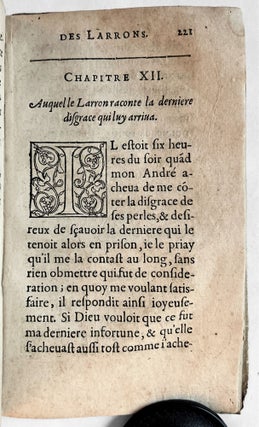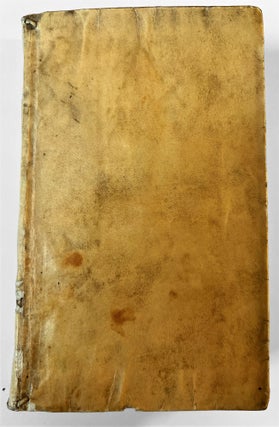L'Antiquité des Larrons. Ouvrage non moins curieux que délectable; Composé en Espagnol par Don Garcia: Et traduit en François, par le Sr Daudiguier. Paris: Toussainct du Bray, 1621.
8vo (167 x 102 mm). [8], 245, [3] pp. Woodcut printer’s device on title, headpiece and initials. Slight discoloration. Contemporary parchment (small holes at joints). ***
First edition in French of a thief’s autobiography. Among the rogue hero’s misadventures are an escape from the prison of Marseille and a failed attempt to swindle an equally wily Lady with Pearls. Digressions include the opening salvo, a scathing indictment of French (and Spanish) prisons, in which the carceral system is deemed Hell on earth: police officials and government agents are the devil’s accomplices, and the sufferings of the imprisoned are those of the damned, deprived of the sight of God. Garcia’s personal experience of prison in France was, if not the main source, then certainly a contributing factor to this passionate condemnation of a system of public order founded on denunciations and cruelty.
Lighter chapters treat the original thieves: the rebel angel and Adam, the nobility of stealing, different types of thieves, and proof that thievery is at the heart of all professions. The final chapter contains the statutes and laws of the Company of Thieves, from basic rules (a thief must always carry a false beard) to required comportment with women (never tell them anything), and identifying marks of different kinds of thieves.
The original Spanish text (La desordenada codicia de los bienes agenos) had appeared two years earlier in Paris, where the author, a physician from Zaragoza, had taken up residence in 1613. Unable to practice medicine in France, he was one of a small group of Spanish and Portuguese writers patronized by a pro-Hispanic faction of notables in the circle of the regent Marie de’ Medici; his first publication was a panegyric pamphlet following the double royal French-Spanish marriages in 1615. Notwithstanding this high-level protection, Garcia’s testimony in a murky witchcraft trial of the regent’s lady-in-waiting Leonora Galigai, executed in 1617, led to his being thrown in jail for eight months.
Vital d'Audiguier, a soldier turned poet for pay, was an important translator of Spanish works (including Cervantes’ Novelas ejemplares and La Vida de Lazarillo de Tormes). He was assassinated at the house of his mistress ca. 1624. In 1658 the Académie française judged his translations among the best written works in French.
I locate two copies in the US (Princeton and Yale). Not in USTC (which locates 6 copies of the Spanish edition, including one in the US, at the Hispanic Society).
Palau 97791; Fouché-Delbosc, Bibliographie Hispano-Francaise, 1477-1700, 1057; Brunet II: 1480; Losada-Goya, Bibliographie critique de la littérature espagnole en France au XVIIe siècle, p. 267, no. 208. Cf. Diccionario Biográfico electrónico; J.-M. Pelorson, “Le docteur Carlos García et la colonie hispano-portugaise de Paris (1613-1619),” Bulletin hispanique, vol. 71(1969), no. 3-4: 518-576. Item #4257
No longer available




